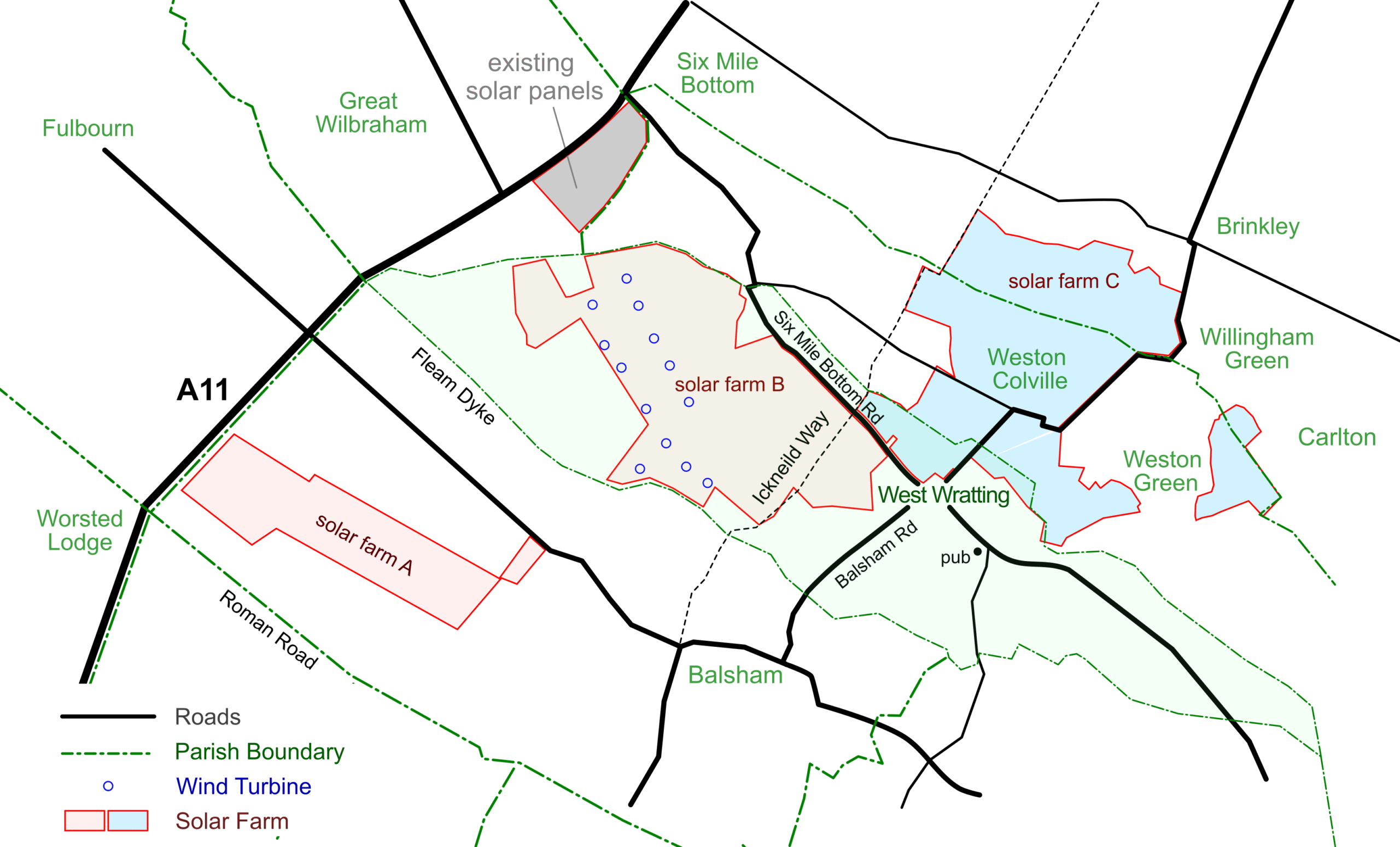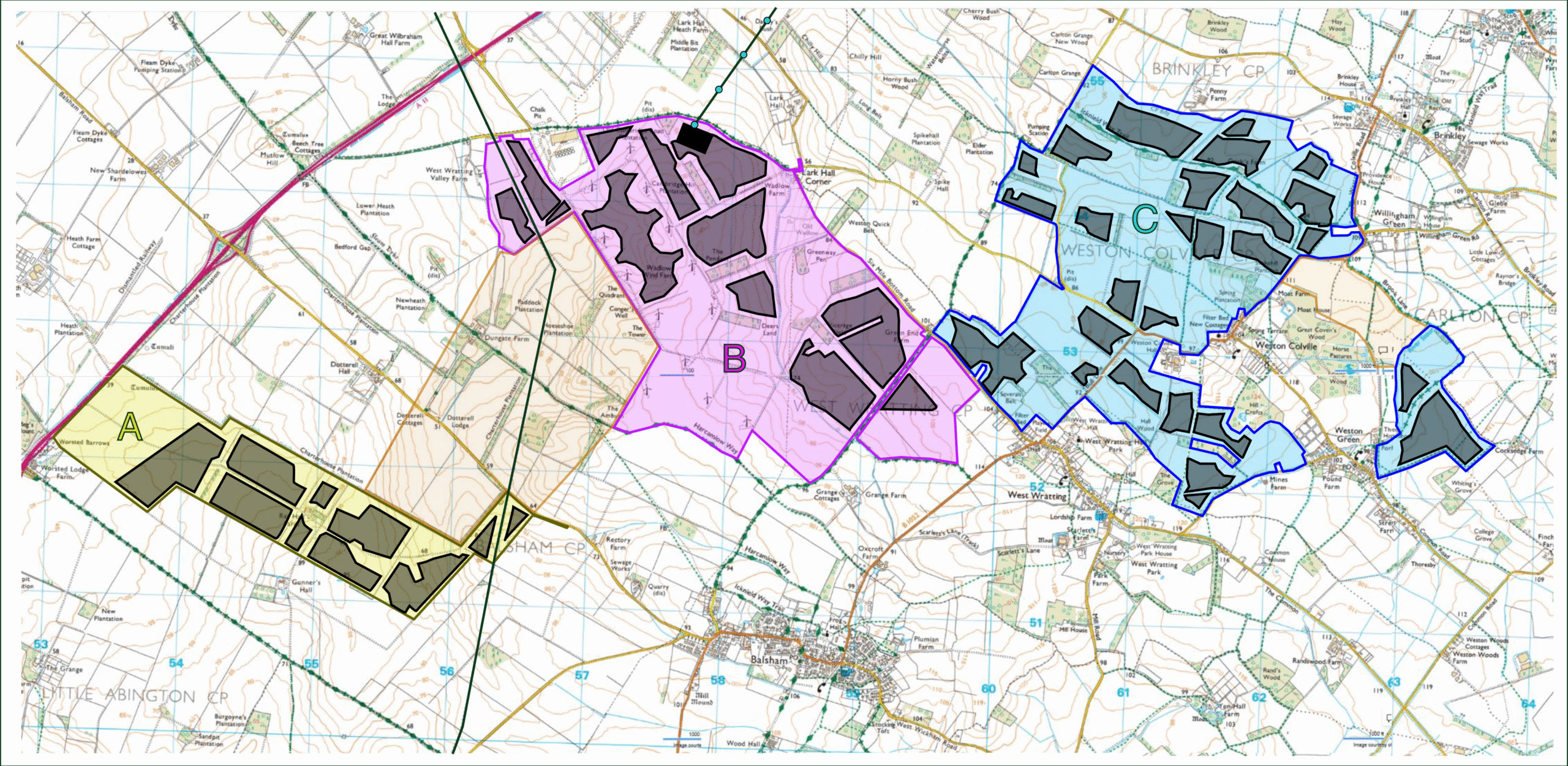Last updated 3rd November 2025.
This page is a home for articles about Kingsway solar ‘farm’ that is proposed to be built in the rural area around West Wratting and Weston Colville.
What do we know about the solar farm plans?
At the start of the statutory consultation period Kingsway published details of their proposal in a set of “PEIR” documents that can be downloaded from here. There are literally thousands of pages, most of them very technical. If you have the time, the best place to start is by reading the 65 page non-technical summary of the PEIR. If you want a quick overview the community action group, KSCA, created an AI-generated summary that is just 4 pages long.
Here’s an updated schematic map showing the overall scale of the solar farm.

This is based on the information available from Kingsway’s new interactive map. The schematic is also available in black and white for printing (e.g., in Challenge).
To show where the solar farm infrastructure will be located we’ve superimposed details from the interactive map on an OS map.

In this the grey areas show where the solar panels will actually be positioned. The black rectangle just West of the Larks Hall double bends is the compound for the battery energy storage system (BESS) containers, and the green line that leads off from there is the start of the 16 km of pylon cable that goes to Burwell. You can download a high resolution version of this map.
The proposed solar and battery farm now covers an area of 1,246 hectares (3080 acres). As with many other large-scale solar farms that are being developed in the UK it is much bigger than solar farms elsewhere in Europe – about 3x bigger. If that’s hard to imagine, think of an area that’s almost 2 miles wide and 2.5 miles long. It’s roughly equivalent to 2000 football pitches.
What’s the next step?
We now need to wait, probably until spring 2026, while Kingsway read and respond to the Statutory Consultation feedback and prepare their Development Consent Order (DCO) application. In the meantime the Kingsway Area Parish Council Alliance (KAPCA) and Kingsway Solar Community Action (KSCA) group will be working together to prepare our case for presentation at the examination stage of this NSIP, which will probably start in summer 2026.

Statutory consultation responses
Here are links (or placeholders if the document is not yet available) to various responses to Kingsway’s statutory consultation, which ended on 29th October 2025. The formal purpose of these comments is to help Kingsway modify their design to meet the concerns of nearby communities.
- West Wratting Parish Council (DRAFT)
- West Wratting Parochial Church Council (PCC)
- Balsham Parish Council
- Bottisham Parish Council
- Weston Colville Parish Council
- Carlton cum Willingham Parish Council
- Horseheath Parish Council
- Burwell Parish Council
- Linton Parish Council
- Little Abington Parish Council
- Swaffham Prior Parish Council
- West Wickham Parish Council
- Kingsway Solar Community Action (KSCA) Group
- South Cambridge District Council (SCDC)
- Cambridge County Council (CCC)
- Cllrs Batchelor and Harvey
- Pippa Heylings, MP (email to constituents)
- Historic England (redacted)
Here are the recommendations we gave about how to responding to NSIP consultation.
Non-statutory consultation responses
Here are links to various responses to Kingsway’s non-statutory consultation, which ended on 12th December 2024. These comments were supposed to be used by Kingsway to modify their design to meet the concerns of nearby communities.
- West Wratting Parish Council
- South Cambridge District Council (SCDC)
- Cambridge County Council
- Balsham Parish Council
- Weston Colville Parish Council
- Brinkley Parish Council
- Carlton cum Willingham Parish Council
- Kingsway Solar Community Action (KSCA) Group
- District Councilor Geoff Harvey, SCDC.
Here are the recommendations we gave about how to responding to NSIP consultation.
Scoping Environmental Impact Assessment (EIA) Report
Here are links to comments on the scoping EIA report by Kingsway that was published in late December 2024 with a deadline for comments of 14th January 2025. In addition to the report’s 313 pages there were several appendices that downloaded from Kingsway’s document library.
The documents listed below were taken into consideration by the planning inspectorate’s scoping opinion (this is a short version that does not include the appendices).
- Comments on the scoping EIA by West Wratting Parish Council.
- South Cambridge District Council (SCDC) with covering letter
- Cambridge County Council
- Balsham, with appendices on impacted views, hydrology and anerobic digester.
- Weston Colville (appendix includes links to their parish plan)
- West Wickham
- Brinkley
- Carlton cum Willingham
- Reach (including their neighborhood plan)
All of the above (and more) are included in an appendix to the full planning inspectorate’s final scoping opinion. To help you find the responses from different councils you can use this table.
Because the consultation period was over the Christmas holiday, one important document missed the deadline for submission to the scoping EIA; it was from Cambridgeshire Fire and Rescue Service, and contained lots of recommendations to cope with risk of fire in the Battery Energy Storage System (BESS). From reading the PEIR documents it doesn’t look like those recommendations have been taken on board by Kingsway.
Here are the recommendations we gave about how to cope with responding to the scoping EIA.
Kingsway Solar Community Action
An action group has been formed to protest against the Kingsway Solar Farm Project. Check out the ‘Kingsway Solar Community Action‘ webpage. The manifesto for KSCA says:
This group is not anti-Solar. It is, however dedicated to advocating for our community’s interests and resisting the proposed Kingsway Solar Farm. We aim to share information about the application, important deadlines, and effective actions, as well as provide comprehensive knowledge to bolster the case for rejecting this proposal.
Have a look at their Report for Residents and Concerned Parties that comprehensively describes many concerns raised by the proposed Solar Farm.
If you wish to protest against the Solar Farm proposal then please contact KSCA.
Useful Links
- The GOV.UK webpage for the Kingsway Solar Farm project.
- Presentation by Kingsway Solar Farm Ltd to Balsham village on 18th March 2024.
- Here is the website of Kingsway Solar Farm Ltd.
- Challenge article April 2024, written immediately after the first presentation from Kingsway in March 2024 about their proposed solar farm.
- The NSIP planning process – this explains how this large infrastructure project will progress to approval by the Secretary of State. If you want to get involved in supporting Kingsway solar farm or campaigning against it then I recommend you learn about this planning process.
- The slightly smaller Sunnica solar farm (2,500-acre) proposed for just North of Newmarket was approved by the new Labour Government in their first week in office (see this BBC article). Essentially the Government decided to ignore the recommendations of their own appointed examining authority – who said that the project should not go ahead – and gave their consent, saying that “the public benefits outweigh the harm identified”. That project is a useful precedent for what may happen to West Wratting.
The website for “Say No to Sunnica” outlines the reasons put forward by that community action group for opposing the project.
We’ve compiled a webpage with links to the written representations that were prepared by Say No To Sunnica. - Joint letter from Lucy Frazer (Conservative Party, Ely and East Cambridgeshire) and Matt Hancock (Conservative, West Suffolk) objecting to the Sunnica Solar Farm.
- I wrote to all the candidates that stood for election in South Cambridgeshire in 2024 to ask for their party’s national policy on the use of agricultural land for solar farms, and for their personal views on the proposed Kingsway development. The only written reply I received before voting day was from the Green party, who said
The Green Party’s targets are for 100 GW of Solar in the UK energy mix by 2035. Predominantly, we seek to prioritise schemes that install Solar PV on residential and commercial rooftops in a way that balances our energy needs with the need to protect biodiversity and our food supply. Contrary to how it’s often presented in the media, it is not Green Party policy to cover vast swathes of arable land under Solar PV, and there have been plenty of instances where Green Councillors have voted against Solar farm schemes due to their unsuitability on those concerns.
I have since received an email from our constituency MP, Pippa Heylings, who is the Lib Dem spokesperson on energy security and net zero, and is also on the Great British Energy Bill Committee. She said:
I have previously spoken out against this proposal and I have been presented with no reason to change my mind. There is, of course, a need for more renewable energy but it is vital that planning for this is guided by a proper land use framework rather than sites being chosen by developers at random. In Westminster, I am pushing for the land use framework that Labour mentioned in their manifesto to be brought forward as well as raising concerns on the importance of community consultation on these schemes and for community benefits. I have also spoken in chamber and in the Great British Energy Bill Committee on the need for community energy projects to be given attention in this Bill. - The Kingsway Solar Community Action facebook group have produced a useful map showing the quality of agricultural land under the solar farm. Kingsway have said “We understand that the protection of agricultural land is a key concern in Cambridgeshire. We are completing an independent agricultural land classification (ALC) survey to assess the quality of the land within the Site and its surrounds. This will inform our efforts to prioritise development in areas of lower agricultural value. This will update the previous ALC surveys that exist, that are 36 years old. These assessments are undertaken with methodologies agreed with Natural England“.
Simon Chandler